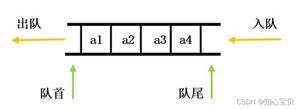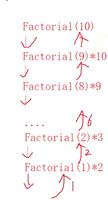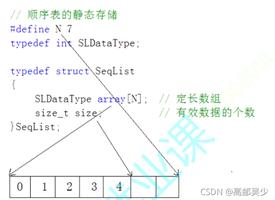C语言数据结构之顺序数组的实现
C语言数据结构之顺序数组的实现
以下为展示顺序数组的示例:
1.用C语言实现的版本
#include<stdio.h> /* EOF(=^Z或F6),NULL */
#include<math.h> /* floor(),ceil(),abs() */
#include<stdlib.h> /*申请和释放内存*/
#include<stdarg.h> /*可变参数*/
#define OK 1 //成功标志
#define ERROR 0 //错误标志
#define MAX_ARRAY_DIM 8 //数组最大维数
typedef int ElemType;
typedef int Status; /* Status是函数的类型,其值是函数结果状态代码,如OK等 */
typedef struct
{
ElemType *base; /* 数组元素基址,由InitArray分配 */
int dim; /* 数组维数 */
intint *bounds; /* 数组维界基址,由InitArray分配 */
intint *constants; /* 数组映象函数常量基数,相当于每一维度的权重值,由InitArray分配 */
}Array;
/* 顺序存储数组的基本操作*/
Status InitArray(Array *A, int dim, ...)
{ /* 若维数dim和各维长度合法,则构造相应的数组A,并返回OK */
int elemtotal = 1, i; /* elemtotal是元素总值 */
if (dim<1 || dim>MAX_ARRAY_DIM) //判断数组维数
{
return ERROR;
}
(*A).dim = dim; /* 数组维数 */
(*A).bounds = (intint *)malloc(dim*sizeof(int)); /* 数组维界基址 */
if (!(*A).bounds)
{
exit(OVERFLOW);
}
va_list ap;
va_start(ap, dim);
for (i = 0; i < dim; ++i)
{
(*A).bounds[i] = va_arg(ap, int);
if ((*A).bounds[i] < 0)
{
return UNDERFLOW; /* 在math.h中定义为4 */
}
elemtotal *= (*A).bounds[i];
}
va_end(ap);
(*A).base = (ElemType *)malloc(elemtotal*sizeof(ElemType));
if (!(*A).base)
{
exit(OVERFLOW);
}
(*A).constants = (intint *)malloc(dim*sizeof(int));
if (!(*A).constants)
{
exit(OVERFLOW);
}
(*A).constants[dim - 1] = 1;
for (i = dim - 2; i >= 0; --i)
{
(*A).constants[i] = (*A).bounds[i + 1] * (*A).constants[i + 1];
}
return OK;
}
/* 销毁数组A */
Status DestroyArray(Array *A)
{
if ((*A).base)
{
free((*A).base);
(*A).base = NULL;
}
else
{
return ERROR;
}
if ((*A).bounds)
{
free((*A).bounds);
(*A).bounds = NULL;
}
else
{
return ERROR;
}
if ((*A).constants)
{
free((*A).constants);
(*A).constants = NULL;
}
else
{
return ERROR;
}
return OK;
}
/* 若ap指示的各下标值合法,则求出该元素在A中的相对地址off */
/* Value()、Assign()调用此函数 */
Status Locate(Array A, va_list ap, intint *off)
{
int i, ind;
*off = 0;
for (i = 0; i < A.dim; ++i)
{
ind = va_arg(ap, int);
if (ind < 0 || ind >= A.bounds[i])
{
return OVERFLOW;
}
*off += A.constants[i] * ind;
}
return OK;
}
/* ...依次为各维的下标值,若各下标合法,则e被赋值为A的相应的元素值 */
Status Value(ElemType *e, Array A, ...)
{
va_list ap;
Status result;
int off;
va_start(ap, A);
if ((result = Locate(A, ap, &off)) == OVERFLOW) /* 调用Locate() */
{
return result;
}
*e = *(A.base + off);
return OK;
}
/* ...依次为各维的下标值,若各下标合法,则将e的值赋给A的指定的元素 */
Status Assign(Array *A, ElemType e, ...)
{
va_list ap;
Status result;
int off;
va_start(ap, e);
if ((result = Locate(*A, ap, &off)) == OVERFLOW) /* 调用Locate() */
{
return result;
}
*((*A).base + off) = e;
return OK;
}
void main()
{
Array A;
int i, j, k, *p, dim = 3, bound1 = 3, bound2 = 4, bound3 = 2; /* a[3][4][2]数组 */
ElemType e, *p1;
/* 构造3*4*2的3维数组A */
InitArray(&A, dim, bound1, bound2, bound3);
/* 顺序输出A.bounds */
printf("输出数组各维度的值:\n ");
p = A.bounds;
for (i = 0; i < dim; ++i)
{
printf("A.bounds[%d] = %d\n ", i, *(p + i));
}
printf("\n");
/* 顺序输出A.constants */
printf("输出数组映像函数常量基数的值(相当于每一维度的权重值):\n ");
p = A.constants;
for (i = 0; i < dim; ++i)
{
printf("A.constants[%d] = %d\n ", i, *(p + i));
}
printf("\n\n");
printf("%d页%d行%d列矩阵元素如下:\n", bound1, bound2, bound3);
for (i = 0; i < bound1; ++i)
{
printf("第%d页:\n", i);
for (j = 0; j < bound2; ++j)
{
for (k = 0; k < bound3; ++k)
{
Assign(&A, i * 100 + j * 10 + k, i, j, k); /* 将i*100+j*10+k赋值给A[i][j][k] */
Value(&e, A, i, j, k); /* 将A[i][j][k]的值赋给e */
printf("A[%d][%d][%d]=%2d ", i, j, k, e); /* 输出A[i][j][k] */
}
printf("\n");
}
printf("\n");
}
p1 = A.base;
printf("顺序输出Array的元素\n");
for (i = 0; i < bound1*bound2*bound3; ++i) /* 顺序输出A.base */
{
printf("%4d", *(p1 + i));
//输出换行
if (i % (bound2*bound3) == (bound2*bound3 - 1))
{
printf("\n");
}
}
/* 销毁数组A */
DestroyArray(&A);
}
运行结果如下图所示:
如有疑问请留言或者到本站社区交流讨论,感谢阅读,希望能帮助到大家,谢谢大家对本站的支持!
以上是 C语言数据结构之顺序数组的实现 的全部内容, 来源链接: utcz.com/z/336956.html





